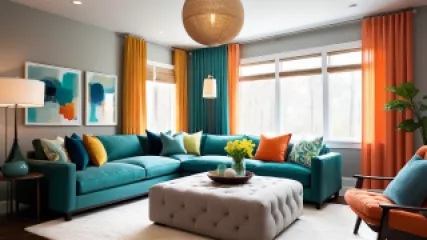Mastering Emotional Well-Being Through Color Choices in Interiors
Colors have a profound impact on our emotions and overall well-being. They can evoke feelings of happiness, calmness, or even sadness. In the realm of interior design, color choices play a crucial role in creating a space that promotes emotional wellness. By understanding the psychology of color and its effects on mood, you can master emotional well-being through color choices in interiors.
The Power of Color
Color has the power to influence our mood and emotions in subtle yet significant ways. It has been studied extensively in the field of psychology, known as color psychology. Different colors have different psychological effects, and understanding these effects can help you create harmonious and balanced living spaces.
Warm Colors:
Warm colors such as red, orange, and yellow are known to stimulate energy and evoke feelings of warmth and excitement. These colors are perfect for areas where you want to create a lively and energetic atmosphere, such as the living room or kitchen. However, it's important to use warm colors in moderation, as excessive use can lead to feelings of restlessness or aggression.
Cool Colors:
Cool colors such as blue, green, and purple have a calming effect on the mind and body. They promote relaxation and tranquility, making them ideal for bedrooms, bathrooms, or any space where you want to create a serene environment. Cool colors can also help reduce stress and anxiety.
Neutral Colors:
Neutral colors such as white, gray, and beige provide a sense of balance and calmness. They create a blank canvas that allows other elements in the room to stand out. Neutral colors are versatile and can be used as a base for any color scheme. They are especially popular in minimalist and Scandinavian interior styles.
Creating a Mood-Boosting Home
Now that you understand the emotional impact of different colors, let's explore how you can use color to enhance mood and promote emotional well-being in your home.
1. Choose Colors Based on Room Function
The function of each room should guide your color choices. For instance, in the bedroom, where relaxation and sleep are essential, opt for cool and soothing colors such as shades of blue or lavender. In contrast, the dining area can benefit from warm colors like red or orange to stimulate appetite and create an inviting atmosphere.
2. Consider Natural Light
Take into account the amount of natural light each room receives when selecting colors. Rooms with plenty of natural light can handle bolder and brighter colors, while rooms with limited natural light may benefit from lighter shades to maximize brightness. Additionally, consider the direction of the sunlight to choose colors that complement the lighting conditions throughout the day.
3. Pay Attention to Color Combinations
Color combinations play a vital role in setting the overall mood of a space. Complementary colors, which are opposite each other on the color wheel, can create a vibrant and energetic environment. Analogous colors, which are adjacent to each other, provide a harmonious and cohesive feel. Experiment with different color combinations to find the perfect balance for each room.
4. Inject Accents of Vibrant Colors
While neutral colors provide a sense of calmness, injecting accents of vibrant colors can add visual interest and energy to a space. Use colorful accessories such as pillows, rugs, or artwork to introduce pops of color. This allows you to easily change the color scheme without committing to a permanent change.
5. Consider Personal Preferences
While color psychology provides general guidelines, it's crucial to consider personal preferences when choosing colors for your home. Everyone has unique associations and emotional connections with certain colors. If a particular color makes you feel happy and relaxed, don't hesitate to incorporate it into your space.
Colors, like features, follow the changes of the emotions.
Pablo Picasso
The Impact of Specific Colors
Let's explore the psychological effects of specific colors and how you can use them to enhance emotional well-being in different areas of your home.
1. Red
Red is a powerful and intense color that evokes strong emotions. It symbolizes passion, energy, and excitement. However, excessive use of red can lead to feelings of restlessness or even aggression. Use red as an accent color in spaces where you want to create a sense of vitality and liveliness, such as the dining area or home gym.
2. Orange
Orange combines the energy of red with the warmth of yellow. It promotes feelings of enthusiasm, creativity, and happiness. Orange is an excellent choice for spaces where you want to foster social interaction and creative thinking, such as the living room or home office.
3. Yellow
Yellow is associated with joy, optimism, and mental clarity. It stimulates the mind and promotes positivity. Yellow works well in spaces where you want to create a cheerful and uplifting atmosphere, such as the kitchen or children's playroom.
4. Blue
Blue is known for its calming and soothing effects. It promotes relaxation, reduces stress, and lowers blood pressure. Blue is an ideal choice for bedrooms, bathrooms, or any space where you want to create a peaceful and serene environment.
5. Green
Green symbolizes nature, growth, and harmony. It has a refreshing and rejuvenating effect on the mind and body. Green is perfect for spaces where you want to create a connection with nature, such as the living room or study area.
6. Purple
Purple is associated with luxury, creativity, and spirituality. It stimulates the imagination and encourages introspection. Use purple in spaces where you want to create a sense of elegance and sophistication, such as the bedroom or meditation room.
7. White
White represents purity, simplicity, and cleanliness. It creates a sense of spaciousness and allows other elements in the room to stand out. White is an excellent choice for small rooms or areas where you want to create a minimalist and clutter-free environment.
8. Gray
Gray is a versatile and timeless color that provides a sense of stability and balance. It works well as a neutral base and can be paired with any color scheme. Gray is often used in modern and contemporary interior design styles.
Conclusion
Mastering emotional well-being through color choices in interiors is a powerful tool in creating a harmonious and balanced home. By understanding the psychology of color and its impact on mood, you can transform your living spaces into sanctuaries that promote mental wellness. Remember to consider the function of each room, the amount of natural light, and personal preferences when selecting colors. With careful thought and consideration, you can create a home that supports your emotional well-being and uplifts your spirits.






